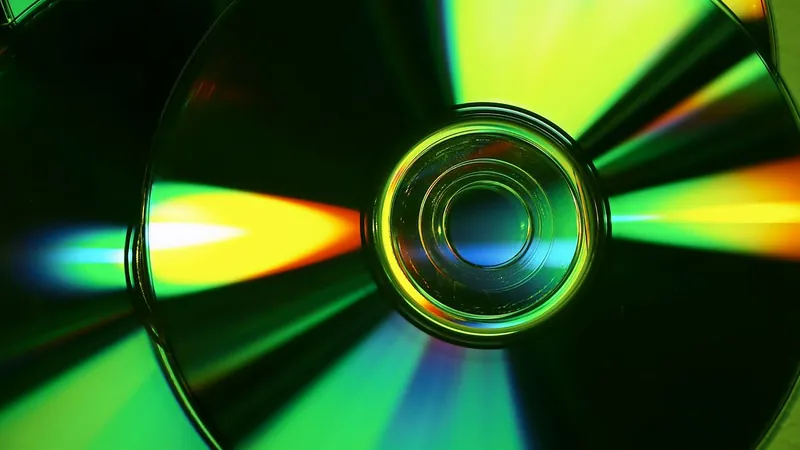
Revolutionary 'Quantum CD' Set to Transform Data Storage, Promising 1,000 Times More Capacity!
2024-10-25
Author: John Tan
Introduction
A groundbreaking advancement in data storage technology is on the horizon thanks to scientists harnessing the extraordinary capabilities of quantum mechanics. Imagine a revolutionary 'Quantum CD' capable of holding up to 1,000 times more data than today's conventional optical discs, such as CDs and DVDs!
How It Works
This innovative ultra-high-density optical memory device utilizes numerous memory cells composed of rare earth elements embedded within magnesium oxide (MgO) crystals. These rare earth elements emit photons—tiny packets of light—that interact with "quantum defects" present in the crystal lattice. These defects, which are essentially vacancies consisting of unbonded electrons, absorb the emitted light and become excited.
Overcoming Limitations
Currently, the storage capacity of optical media is hindered by the diffraction limit of light. This limitation restricts the size of individual data pieces to the wavelength of the laser used for reading and writing. However, a promising technique called "wavelength multiplexing" could enable optical discs to store significantly more data by employing slightly varied light wavelengths simultaneously.
Recent Findings
Recent research has revealed that integrating MgO with narrowly emitting rare earth elements allows for these elements to emit light at specific, tightly packed wavelengths. The findings, published on August 14 in the esteemed journal *Physical Review Research*, offer an optimistic outlook on the future of data storage technology.
Research Insights
Lead researcher Giulia Galli, a professor at the University of Chicago's Pritzker School of Molecular Engineering, remarked, "We worked out the basic physics behind how the transfer of energy between defects could realize an incredibly efficient optical storage method." This new study meticulously modeled how light propagates at the nanoscale to comprehend the movement of energy between these rare earth emitters and the quantum defects, along with how these defects can efficiently store the absorbed energy.
Unique Photon Size
What sets this technology apart is the unique photon size generated by these emitters—dramatically smaller than those produced by conventional optical or near-infrared lasers. Traditional photons can measure between 500 nm to 1 micrometer, while those emitted from rare earth elements are significantly more efficient for data storage. This is the key to unlocking a dramatic increase in data density, with potential implications for everything from everyday data storage solutions to enhanced cloud computing.
Energy Transition
The researchers made an exciting discovery: when quantum defects absorbed energy from the narrow-band light, they transitioned from their neutral (ground) state to an excited "spin state." This transition is notably stable, suggesting that such defects have the potential for retaining data for extended periods, although further investigation is needed to quantify storage longevity.
Future Challenges
Most current quantum technologies require ultra-cold conditions near absolute zero to minimize decoherence and dephasing—phenomena that lead to corruption in quantum systems. A major breakthrough is necessary to adapt this promising technology to function effectively at room temperature, ensuring practicality for everyday applications.
Conclusion
As we stand on the verge of a data storage revolution, this 'Quantum CD' could redefine how we store vast amounts of information, setting the stage for an exciting future of digital accessibility. Stay tuned for more updates as researchers continue to explore this cutting-edge technology!



 Brasil (PT)
Brasil (PT)
 Canada (EN)
Canada (EN)
 Chile (ES)
Chile (ES)
 Česko (CS)
Česko (CS)
 대한민국 (KO)
대한민국 (KO)
 España (ES)
España (ES)
 France (FR)
France (FR)
 Hong Kong (EN)
Hong Kong (EN)
 Italia (IT)
Italia (IT)
 日本 (JA)
日本 (JA)
 Magyarország (HU)
Magyarország (HU)
 Norge (NO)
Norge (NO)
 Polska (PL)
Polska (PL)
 Schweiz (DE)
Schweiz (DE)
 Singapore (EN)
Singapore (EN)
 Sverige (SV)
Sverige (SV)
 Suomi (FI)
Suomi (FI)
 Türkiye (TR)
Türkiye (TR)
 الإمارات العربية المتحدة (AR)
الإمارات العربية المتحدة (AR)